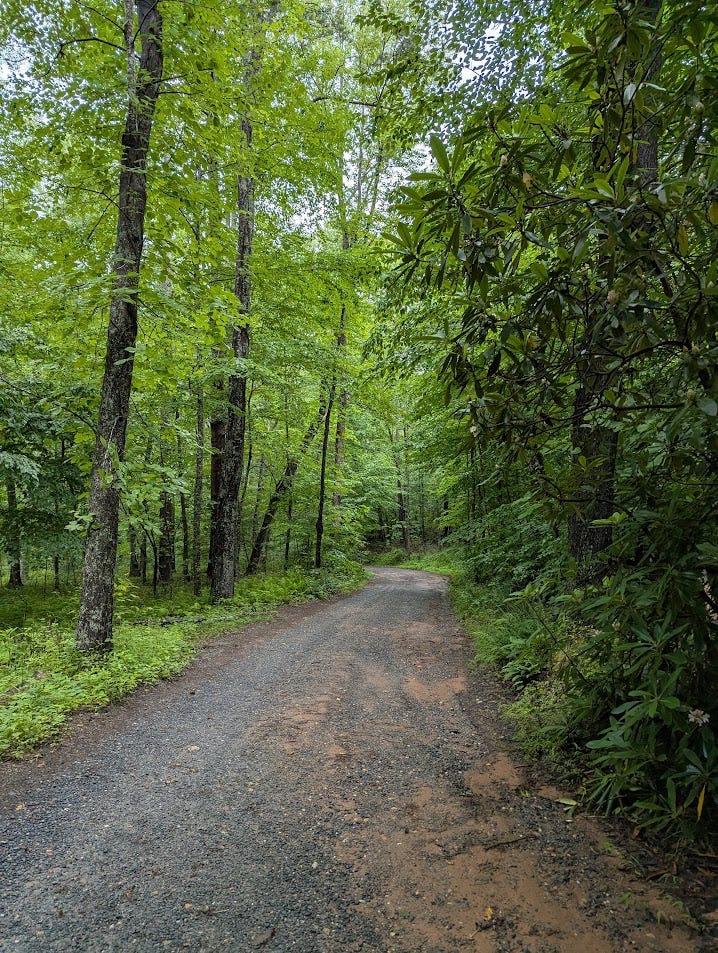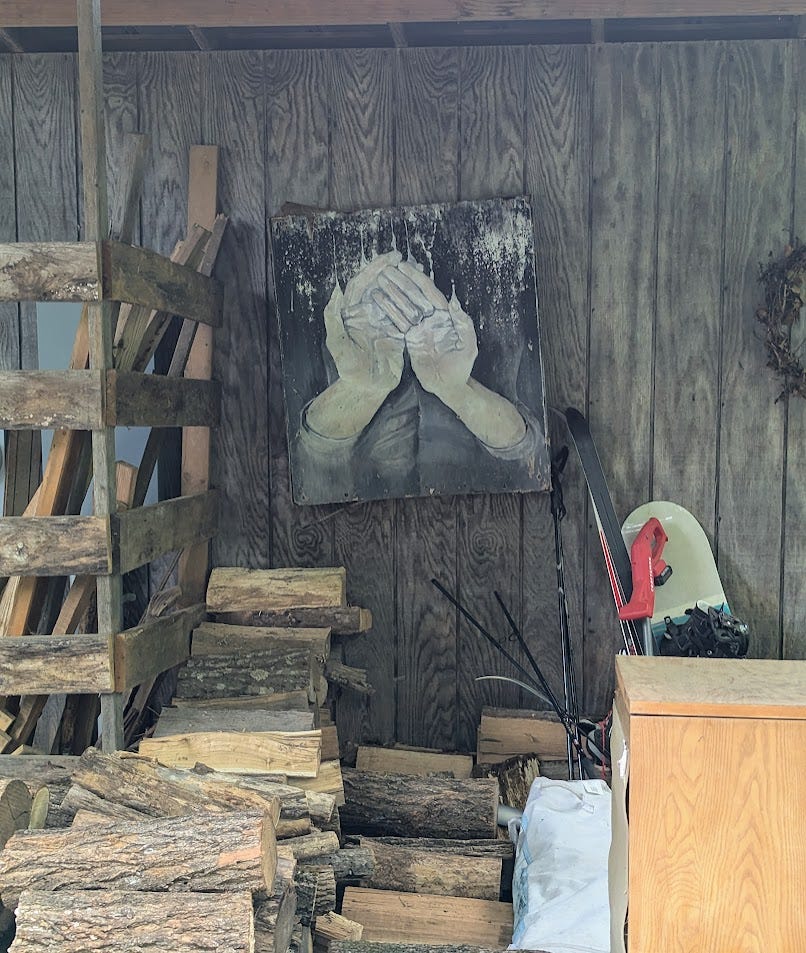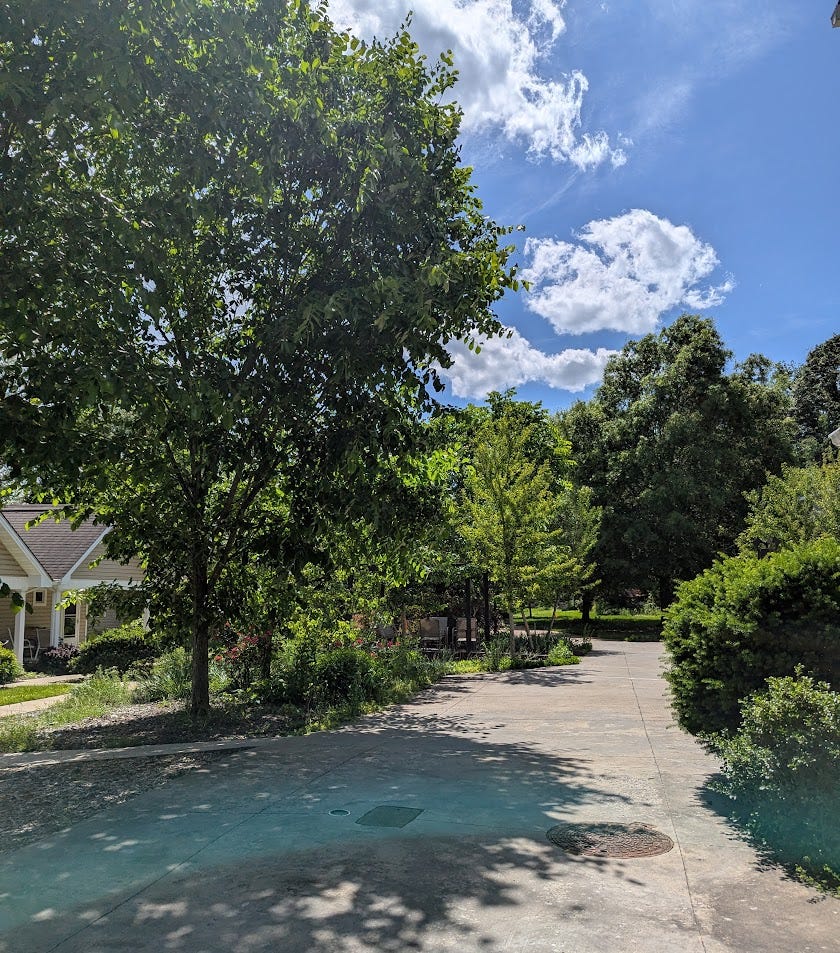Ways to Live in a Fractured Time
Or, there may be nothing more American than intentional communities.
We were of all creeds and opinions, and generally tolerant of all…We had individually found one thing or another to quarrel with in our past life, and were pretty well agreed as to the inexpediency of lumbering along with the old system any further. As to what should be substituted, there was much less unanimity.
—Nathaniel Hawthorne, The Blithedale Romance“Wherever you go, there you are.” —Buckaroo Banzai
Community with Intention
I’ve been exploring intentional communities, past and present. What would it be like to throw in one’s lot with people who’ve envisioned a smart, supportive, sustainable way to live and built it on a patch of land? Is it possible (asking for a friend) to be an independent-minded, introverted cat lady in a communal project?
Every time I’ve raised this topic in conversation, somebody has reasonably asked, “What’s an intentional community?” I always stumble over the answer. Today, worn out from shopping in the heat, I know what it’s not: Target. In crowded, brightly lit aisles that look the same in every town, we dodge past each other, eyes averted, to fill our carts with products named to connote virtue: Good & Gather. Made Good. A New Day. Quest. Target, by which I mean our disconnected lives shrink-wrapped in marketing slogans, is both all-American and completely weird. If a tornado blew off the roof of the store, I’m sure we’d forget our carts full of crap and help each other, holding onto strangers’ kids. We’d instantly become a community with an intention. But after the storm passed, at least a few people would whip out their phones to tweet a conspiracy theory about weather-controlling Jewish space lasers. Sometimes I feel as if we’re living in a George Tooker painting.
Anyway, an intentional community is really just what it sounds like: 5, 50, or 500 people joining together as a team to create and sustain the kind of place where they want to live. In practice, these communities take many different forms. The unifying force may be an ideology or a belief system, or it may just be a mindful way of living in relationship to nature and each other: private homes with shared gardens and woods, a community center, mutual aid, and a welcoming vibe. Some, like the lovely ElderSpirit community, which I visited in May, even welcome off-site membership.
Recently, a poet and naturalist friend kindly invited me to visit her at Shannon Farm Community, a rural intentional community near Charlottesville where she’s lived for decades. Founded in the 1970s, SFC consists of more than 500 communally owned acres of forests, pastures, and hayfields with eight clusters of houses. Each family builds their own house or rents one affordably. On a walking tour along narrow gravel roads, I saw many styles of architecture, including a geodesic dome dating back to the ‘70s. Amelia and her first husband built their beautiful timber-frame house with the help of the community: the frame went up like an Amish barn raising.


No radical ideology needed—just neighbors putting their backs into mutual aid, as used to be the necessity a couple of centuries before Target and Twitter.
People in a community like SFC have their own private lives, but each contributes in some way to the collective good: tending gardens and forest, leveling gravel roads, and participating in committees and decision making. It’s an ideal place for people who know and care about native plants and take their stewardship of the land seriously.
Someone asked me if people walked around naked there, based on the one other “alternative community” he’d heard of. I snorted out loud at the notion of botanists and farmers cavorting naked in the tick-infested woods, but hey, if they did, I expect nobody would mind.

Other intentional communities like Twin Oaks, an even older Virginia venture, are fully communal projects with systems of shared property and income. I first learned of Twin Oaks the summer after grad school when I volunteered at a shelter and soup kitchen for the homeless in Richmond. I muddled along as the cook with help from church and community groups and individual volunteers. Once a month, Twin Oaks folks would breeze cheerfully into the kitchen with a fully cooked meal and vats of creamy, delicious homemade yogurt. I’ve probably forgotten whole years of my life since then—people, places, events—but I still remember that yogurt.
An American Tradition
Although the intentional communities movement is global, it strikes me that there is nothing more deeply American. Didn’t the first English and European settlers sail across an ocean with communal intent? Jamestown, Plymouth, and Salem fit the term, and Native American settlements long before them. My heart is with tolerant Transcendentalists rather than punishing Puritans, so I started Hawthorne’s The Blithedale Romance, loosely based on his time at Brook Farm community, before the trip to SFC. Turning back onto paved highway with a last crunch of gravel beneath my wheels, I listened to a couple more chapters on the way home.

In 1840s Massachusetts, there was something in the soil for dreamers and dissenters. Great literature grew from anthills and heaps of manure. Within four years of each other, Hawthorne and Thoreau both quit their town comforts for experimental living in nature. Thoreau, the curmudgeon, famously went to Walden Pond “to live deliberately” and document the epic battles of ants; Hawthorne, the dark romantic, went to Brook Farm to milk cows, hoe potatoes, and save up money to get married.
Other members of the Brook Farm experiment had more utopian intentions. One of the founders, Rev. Ripley, expressed a vision that arose from “dissatisfaction with the existing conditions of society”:
[The aim was] to insure a more natural union between intellectual and manual labor than exists; to combine the thinker and the worker as far as possible in the same individual; to guarantee the highest mental freedom by providing all with labor adapted to their tastes and talents, and securing to them the fruits of their industry; to do away with the necessity of menial services by opening the benefits of education and the profits of labor to all; and thus to prepare a society of liberal, intelligent and cultivated persons, whose relations with each other would permit a more wholesome and simple life than can be led amidst the pressure of our competitive institutions.
In true Yankee fashion, the plan included mind-your-own-beeswax personal freedom. Residents lived their own lives outside the workday, for which everyone was paid equally. Neighbors looked askance at the project, fearing moonlit orgies in the fields, but nobody ran around naked at Brook Farm; its members were as modest, sober, and early to bed as their Puritan ancestors might have wished. In fact, Hawthorne was so worn out from his daily labors there that he didn’t even have the energy to write.
Notably, the great Transcendentalist Emerson declined to support the utopian experiment, comparing it with alarm to “a French revolution in small.” Did he think they were going to radicalize the cows? Boston author Mary Caroline Crawford suggested that Emerson’s unwillingness to support the community was “due less to disinclination to venture his money than to his inherent dislike of organization, and to his exaggerated reverence for his own selfhood.” (Note to self: read more Mary Caroline Crawford.)
The community flourished for a few years but struggled to support itself with farming and sale of handmade items. Ultimately, they had to make a buck to survive just like everybody else.
This passage in The Blithedale Romance is one of several that made me laugh out loud. The terse, grumbling Silas is surely based on a real-life farmer hired at Brook Farm to help them keep afloat:
"We shall never make any hand at market gardening," said Silas Foster, "unless the women folks will undertake to do all the weeding. We haven't team enough for that and the regular farm-work, reckoning three of your city folks as worth one common field-hand. No, no; I tell you, we should have to get up a little too early in the morning, to compete with the market gardeners round Boston."
It struck me as rather odd, that one of the first questions raised, after our separation from the greedy, struggling, self-seeking world, should relate to the possibility of getting the advantage over the outside barbarians in their own field of labor.
Then in 1844, a newly constructed community building burned down, and the farm never recovered financially. Brook Farm closed for good in 1847.
Hawthorne lived and worked at Brook Farm for six months. Later in 1851, after marrying painter and illustrator Sophia Peabody, he wrote The Blithedale Romance. I just finished the book last night with mixed feelings. Hawthorne was a brilliant, perceptive, often hilarious observer of human nature, but I wish he’d skipped the contrived love triangle and <*spoiler alert*> Ophelia-like drowning. In calling the story a romance, he indicated that it explored truths of the human heart without a novel’s obligation toward realism. Still, many details have the ring of real experience.
Here is one last passage, the narrator’s description of the dreamy-eyed visitors who’d come to admire their picturesque labor:
In their view, we were as poetical as Arcadians, besides being as practical as the hardest-fisted husbandmen in Massachusetts….they gave us credit for imbuing the ordinary rustic occupations with a kind of religious poetry, insomuch that our very cow-yards and pig-sties were as delightfully fragrant as a flower garden. Nothing used to please me more than to see one of these lay enthusiasts snatch up a hoe, as they were very prone to do, and set to work with a vigor that perhaps carried him through about a dozen ill-directed strokes.
Alas, I suspect I’d fare just as comically badly with farm implements as those Blithedale tourists. At Shannon Farm Community, beautiful as it was, I dreaded getting lost in the woods and compulsively checked myself for ticks. When we went wading in a rain-swollen stream, I let out a blood-curdling YEEEK as my feet sank into the muddy, slippery bottom. In some primitive part of my brain, I think I expected to be attacked by leeches and eels.
I may have to stick to admiring rural communities—historical, literary, and a ways up the road—from my desk.
Which brings me back to ElderSpirit, a suburban community in the Blue Ridge that I genuinely can imagine retiring to someday. The visionary part from their website: “This is a unique intentional, mixed-income, participatory, co-housing community of elders, 55 and older. Recognizing that this is a time in our lives to explore and cultivate the spiritual aspects of our nature, we are committed to aging in community, with spirit. Living closely in community provides many opportunities for personal awareness, growth and social well-being.”
I may suck at gardening, but I could offer tech support and a deep interest in people’s stories. With a hiking trail in the backyard and a coffee shop within walking distance, it might be the place to finish my novel. And yep, there’s a Walmart just down the road.





Jody, what an imagination-expanding piece, to describe so vividly the intentional communities past and present! I would sign up if I could pack up and my whole herd! But like you, I think as much as I love the forests, mountains and rivers. I suspect I too would be checking for ticks, especially since I had the totally freak out experience finding and removing them from my foster dog, Chip! But is it possible to imagine an intentional community set in less country-side settings? I’d love to explore that.
The other week, I found myself on a website directory for intentional communities. They are substantially concentrated in the USA, skewed towards the eastern side of the country. A minority are listed in Europe. Our country has over 400 of these! I visited a few in my home state and metro area. They are all very interesting, most are too densely populated for my taste. I think I'd do well in one, not so sure about my wife. However, I do long to downsize to a very small community, maybe an hour's drive outside the big city, a place just large enough for a single four-way stop sign, a small grocery, a cafe and a hardware store. It would be a place where I could know half the town by first name and the other half at least by location and surname.
The core concept is about connections. I live in a rural-like enclave within the big city. However, within 1/2 mile on all sides, one re-enters the large metro area, so my neighbors and I rarely see each other at the grocery store, the gas station or sitting in a local cafe. Thus, it's taken the better part of 7 years to get to know them, and I'm a sort of muted version of a gregarious guy. I like to pause and chat with neighbors who are out in their yards, walking their dogs, picking up the mail, etc. Still, I know far more dogs by name than their associated humans. The art of creating community isn't automatic, takes effort, particularly when there aren't convenient circumstances that foster the knowing of one another. That's where the grocery store, hardware store and cafe come in. Standing in line together, sitting at adjacent tables several weeks in a row, looking for exactly the right widget to repair that other thingamajig is where random encounters become acquaintances and then friendships. I wonder how organic and guaranteed an experience it would be to move to a place with the express intention of creating that kind of connection or sense of belonging? What happens if, 3 years later, you still don't know your neighbors first name. Is that your failure or failure of the concept, or both? Perhaps the design takes care of that, when each neighbor is expected to participate on at least one community committee or rotate through preparation of a community meal.
I think it may come down to pedigree; you can take a boy out of the country, but you can't take the country out of a boy.